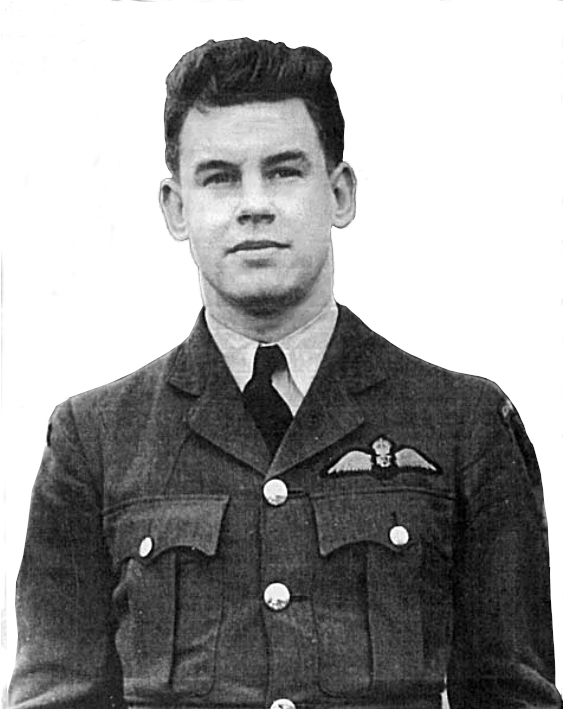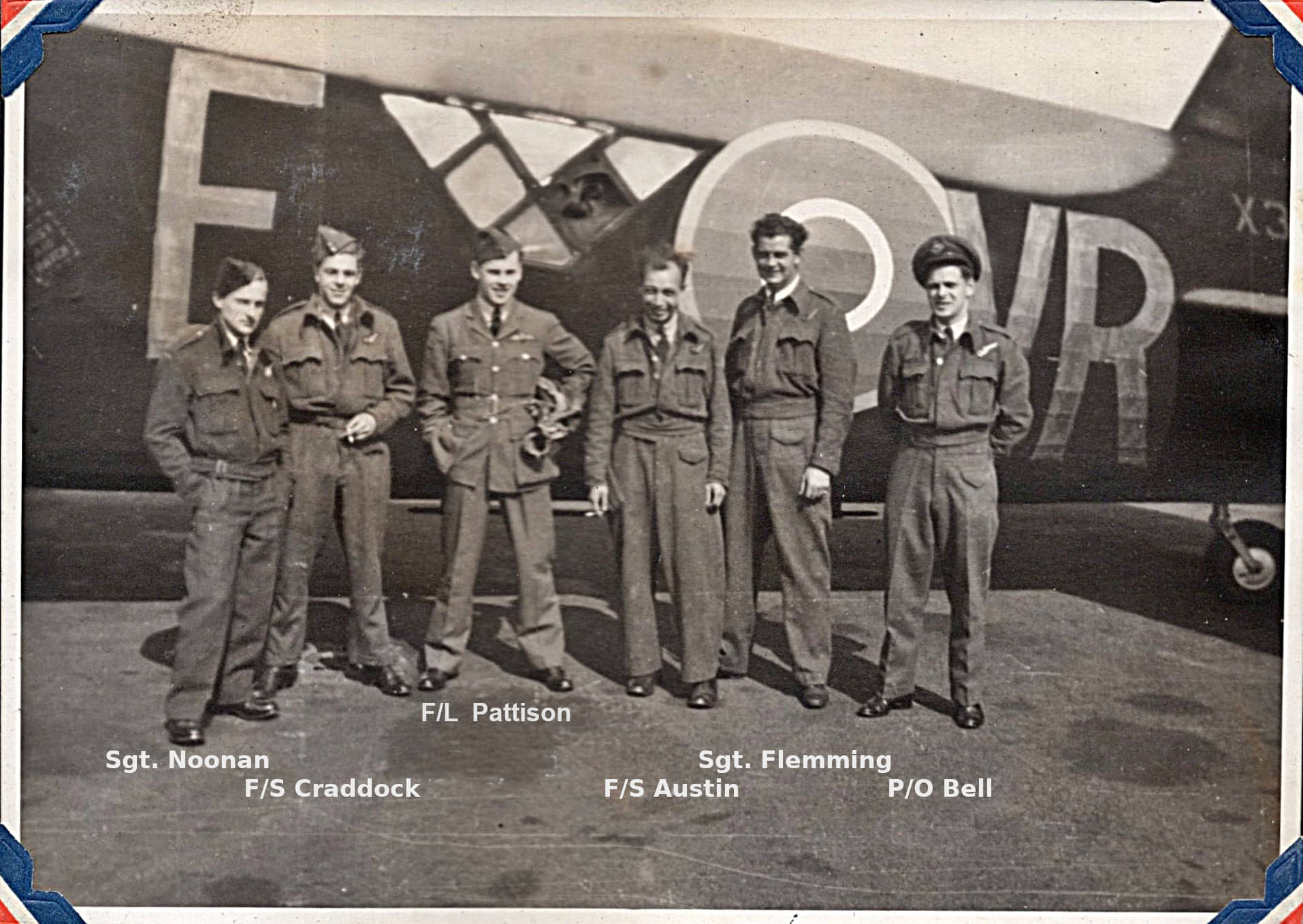
Pre 419 Squadron

John Pattison enlisted on December 13th 1938. Receiving his pilot's wings on October 27th 1939. He was commissioned during that same year.
Pattison was then posted to No.110 (City of Toronto) Auxiliary Squadron flying Canadian built Lysander aircraft. In 1939 No. 110 became the first Canadian squadron to be sent overseas.
The Battle of Britain caused a drain on the RAF's supply of pilots. Pilots from RCAF squadrons were posted to squadrons fighting in the Battle of Britain. On August 30th 1940 F/O Pattison was posted to No.1 RCAF Squadron. It would be while with this squadron he took part in this famous battle for the survival of Britain.
First Tour with 419 Squadron
F/L Pattison arrived at 419 Squadron in March of 1942. He completed his compulsory 2nd. Pilot operations on April 24th.
On May 2nd. 1942 he flew with his own crew on their first operation together. Their Wellington serial number X3470 was met with "accurate anti-aircraft fire" while they laid their pattern of mines off Ile de Re. On leaving this Western coastal area of France they headed North East across France to Laval. Over the town of Laval four bundles of leaflets were dropped as part of a "Nickel" operation.
The Pattison crew were:
P/O Bell Navigator
Sgt. Flemming WAG
F/S Craddock A/G
F/S Austin Wireless Operator
Sgt. Vincent Noonan RAAF Wireless Operator
The crew's Wireless Operator changed a number of times from May until September 1942. On May 6th. F/Sgt. Austin became the Wireless Operator. On July 7th the Wireless Operator became Sgt. Noonan (RAAF) and he continued to fly with the crew up until their Tour was completed in September of 1942. Noonan then flew a number of "air test" flights on squadron Wellingtons with F/L Pattison.
Sgt. Noonan was KIA with the crew of Wellington BK270, on October 15th. 1942. P/O Bell (later S/L Bell) became a POW at Stlag Luft I.
On Oct. 1st with the rank of Acting Squadron Leader, A/S/L Pattison reported to RCAF HQ.
Second Tour with 419 Squadron
On April 23rd. 1943 S/L Pattison arrived from No. 1659 H.C.U. taking command of "B" Flight, replacing S/L D.W.S. Clarke.
He arrived during the beginning of series of nine operations on the Ruhr valley. The second of these operations was Essen on the night of April 30/ May 1st.
Essen would be a "Snafu" created by Command indecision and other factors.
As reported in the April Summary in the Operational Record Book for April 30/May1.
Fourteen aircraft were assigned to the operation. Five of which were forced to turn back to Base on account of icing as well as other mechanical failures.
S/L Pattison and eight other crews of "B" Flight burrowed through the conditions to reach the objective. There they met heavy and accurate flak. The situation was made worse by the lack of proper target markings; even the final turning point flares were only vaguely visible. Two of crews had to rely on ETA timing to locate what they hoped was the target area.
S/L Pattison and eight other crews of "B" Flight burrowed through the conditions to reach the objective. There they met heavy and accurate flak. The situation was made worse by the lack of proper target markings; even the final turning point flares were only vaguely visible. Two of crews had to rely on ETA timing to locate what they hoped was the target area.
To illustrate better what a "Snafu" operation this Essen "doo" had been
practically from beginning to end, excerpts are being borrowed from the
diary of S/L Pattison, . "B"-Flight Commander.
I briefed the squadron at 1800 hours, after the take-off time had been changed several times and Command had refused to decide whether it would be the sky-or ground-marking technique by PFF. After briefing, the Group Captain read us a message from Joe Stalin thanking us for hitting the great German industrial centre s. The met. wallahs were a little unsure of themselves tonight, forecasting a westerly wind for take -off, a grea t front over the North Sea, and solid cloud over Europe from the ground up to 15,000 feet. Then, from out 6f nowhere, those same weather merchants dug up some new winds and a new position for the frontal system over the North Sea, all of which necessitated a change in our tactics and also a much earlier take-off.
There followed bags of panic as harassed navigators sweated to prepare their new flight plans and worried-looking skippers scuttled about rounding up crew member s who had temporarily "bogged off". Then, to complicate matters further, the local wind changed. All the aircraft had therefore to taxi in the dark from one end of the aerodrome to the other, a feat that was somehow performed without a single kite's becoming stuck in the mud. As I was taxiing my aircraft to the marshalling point, flying control sent a man out to tell me that the met. people had changed their minds and that there would be west wind for take-off after all. So we marshalled at the east end of the drome, which proved to be the right end. This caused considerable confusion, as all the aircraft were taxiing out by this time, and positioning themselves at the other end of the field. But the mess finally straightened itself out.
"W" - Willy, myself and crew got airborne on time and climbed over base, setting course at 17,000 feet. Almost at once we ran into the front and were flying in thin cloud with solid stuff below us ... This gave us good protection from fighters but made it impossible to use astronavigation as only the stars directly above us were visible. We reached the Dutch coast at 22,000 feet and met little opposition. At the turning point in Germany just north of the target we were fifteen minutes late because of faulty winds ... From then on, despite our relatively great height, we .were subjected to rather intense and accurate flak.
When our ETA over the target was up, there were no target markers to be seen and I was getting a little worried, especially since we were being buffeted about by flak; and the Ruhr is no place in which to lose one's bearings. Just then a white flare burst behind us, followed by a red which shot out green stars ... We swung around to do an orbit and get back on the proper heading for a bombing run. I don't think there was another aircraft around at the time, because we got quite a pasting on that bombing run. We could hear the "crumpslt of bursting shells and the tinkling of splinter s on our wings and fuselage ... We had an uneventful trip home, except that the gunners, (Sgts. G. F. Clarke and J. A. Mills) were very cold. The temperature up there was minus 40 degrees Centigrade ...
I briefed the squadron at 1800 hours, after the take-off time had been changed several times and Command had refused to decide whether it would be the sky-or ground-marking technique by PFF. After briefing, the Group Captain read us a message from Joe Stalin thanking us for hitting the great German industrial centre s. The met. wallahs were a little unsure of themselves tonight, forecasting a westerly wind for take -off, a grea t front over the North Sea, and solid cloud over Europe from the ground up to 15,000 feet. Then, from out 6f nowhere, those same weather merchants dug up some new winds and a new position for the frontal system over the North Sea, all of which necessitated a change in our tactics and also a much earlier take-off.
There followed bags of panic as harassed navigators sweated to prepare their new flight plans and worried-looking skippers scuttled about rounding up crew member s who had temporarily "bogged off". Then, to complicate matters further, the local wind changed. All the aircraft had therefore to taxi in the dark from one end of the aerodrome to the other, a feat that was somehow performed without a single kite's becoming stuck in the mud. As I was taxiing my aircraft to the marshalling point, flying control sent a man out to tell me that the met. people had changed their minds and that there would be west wind for take-off after all. So we marshalled at the east end of the drome, which proved to be the right end. This caused considerable confusion, as all the aircraft were taxiing out by this time, and positioning themselves at the other end of the field. But the mess finally straightened itself out.
"W" - Willy, myself and crew got airborne on time and climbed over base, setting course at 17,000 feet. Almost at once we ran into the front and were flying in thin cloud with solid stuff below us ... This gave us good protection from fighters but made it impossible to use astronavigation as only the stars directly above us were visible. We reached the Dutch coast at 22,000 feet and met little opposition. At the turning point in Germany just north of the target we were fifteen minutes late because of faulty winds ... From then on, despite our relatively great height, we .were subjected to rather intense and accurate flak.
When our ETA over the target was up, there were no target markers to be seen and I was getting a little worried, especially since we were being buffeted about by flak; and the Ruhr is no place in which to lose one's bearings. Just then a white flare burst behind us, followed by a red which shot out green stars ... We swung around to do an orbit and get back on the proper heading for a bombing run. I don't think there was another aircraft around at the time, because we got quite a pasting on that bombing run. We could hear the "crumpslt of bursting shells and the tinkling of splinter s on our wings and fuselage ... We had an uneventful trip home, except that the gunners, (Sgts. G. F. Clarke and J. A. Mills) were very cold. The temperature up there was minus 40 degrees Centigrade ...
S/L Pattison flew his last operation with 419 Squadron on the night of June 19/20 1943.
With his new promotion to Wing Commander came a posting to command 429 Squadron. Where he continued on as Squadron Commander from July 30th to March 3rd 1944.
From his 419 crew F/S McLean, F/O Smith and Sgt. Clarke also were posted to 429 Squadron at the end of August 1943.
On his second return to Canada he was posted to command of No.145 Squadron, flying Lockheed Hudson and Ventura aircraft. The squadron was part of Coastal Commands anti-submarine mission. He held this posting from March 1 to June 30th 1945 when the squadron was disbanded.